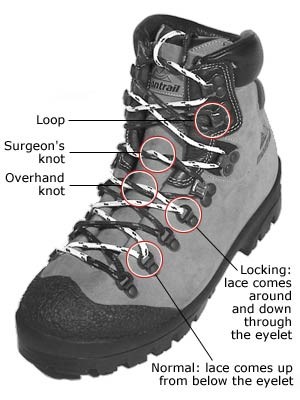Tying Your Boots (How-To)
Flat Feet vs. High Instep
If you have relatively flat feet, the traditional cross over pattern will generally suffice for the comfort of the top of your foot. If you have a high instep, you may need to allow additional space at the top of your foot. You will need to lace your boot with the laces going straight up your boot.
Lock and load
If you ever have had black toes or heard of someone developing black toes due to wearing improper fitting hiking boots, pay close attention. Hiking boots generally have a transitional type of lacing system at the top of your foot. Instead of continuing the criss-cross pattern of lacing, tie a surgeon’s knot to lock your foot into your boot.  A surgeon’s knot is just an additional overhand knot on the lace. When you pull down on both laces, the surgeon’s knot will grab and will not let go. This is the lock portion. Try another locking technique by lacing around and down through the eyelet or hook instead of coming up from below the eyelet.
A surgeon’s knot is just an additional overhand knot on the lace. When you pull down on both laces, the surgeon’s knot will grab and will not let go. This is the lock portion. Try another locking technique by lacing around and down through the eyelet or hook instead of coming up from below the eyelet.
Load Portion
Thread your laces up on the next 2 eyelets or hooks. Do not use the traditional criss-cross pattern of lacing. Now, cross over the laces going underneath the vertical lace on the opposite side of the shoe and pull up on both laces. You will notice the load portion of this lacing technique. The boot will become quite snug at this point. If you have another hook or eyelet use the traditional cross over technique and tie an overhand knot to secure the boot. Don’t tie your laces around the top of your ankle too tight, as you might cause additional discomfort.
Practice, Practice, Practice lacing your boots
Hiking uphill or downhill often requires different lacing techniques for your hiking boots. Use the lock and load technique for downhill hiking. Uphill requires more bend in your ankle. If you lace your boots back and forth in the traditional off-the-rack style, this technique generally does not work well for continuous uphill hiking. Different boots and different feet require different lacing techniques. Practice using different lacing techniques and your feet will thank you.
(Originally submitted by Glen Thompson, November 2015)


